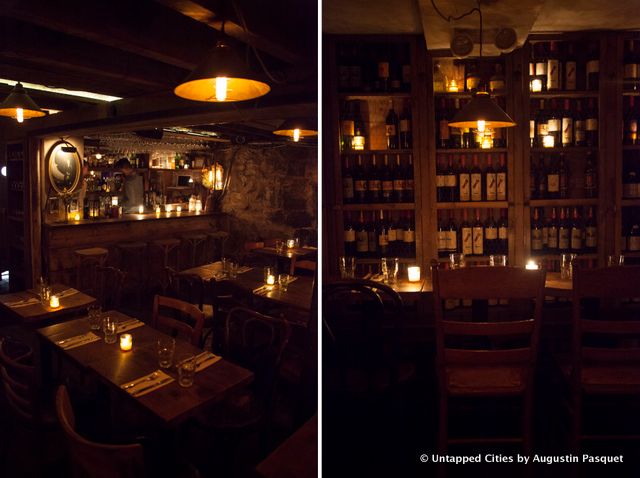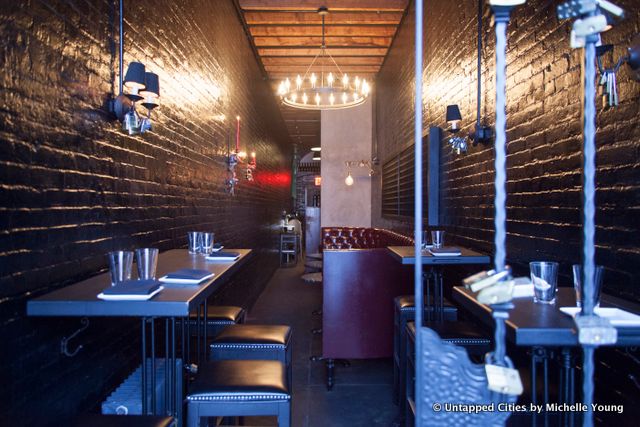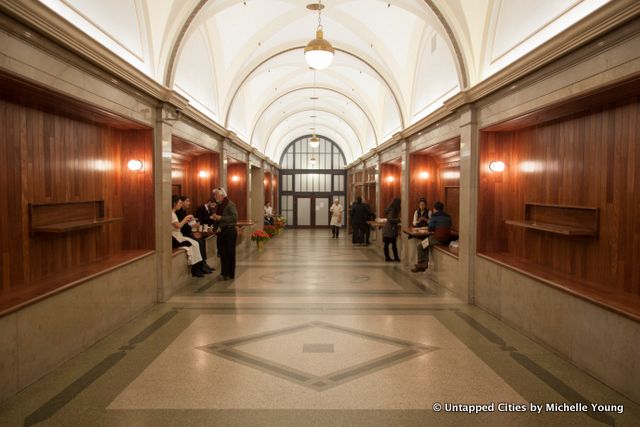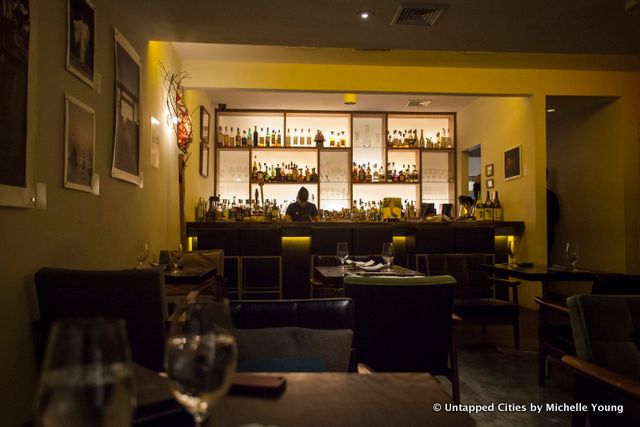Last Chance to Catch NYC's Holiday Notalgia Train
We met the voices of the NYC subway on our nostalgia ride this weekend!



Releasing on October 7th (but already available for pre-order on Amazon) will be the new guidebook, New York: Hidden Bars & Restaurants written by Untapped Cities founder Michelle Young and the site’s contributing editor Laura Itzkowitz. As an update to our popular NYC Hidden Restaurants guide on Untapped Cities from 2014, below is our guide for 2015 with descriptions excerpted from the upcoming book.
Upon reviewing the 2015 list, you may wonder where some of the classic hidden restaurants are–Kuma Inn, La Esquina, the ski chalet behind Cafe Select–just to name a few. As they have been featured in our previous list, we’ve aimed for a wider range of dining types here, from cafes to lunch counters to a referral-only restaurant. This list will get you beyond the trendy to some of the more unique hidden restaurants in New York City.

On the northern edge of Boerum Hill, Brooklyn, a large Hare Krishna temple stands as an anomaly, surrounded by dollar pizza joints and public welfare offices. Judging by the outside, you would never know that there’s a vegetarian lunch canteen inside—a neighborhood spot unspoiled by guidebooks, most of which wouldn’t be interested in such a modest, unglamorous place anyway. But for Hindu devotees, neighborhood residents, and office workers, Govinda’s is a convenient spot to get a cheap, healthy, and delicious vegetarian lunch in keeping with the Hare Krishna principles of nonviolence and service to god (Krishna) through vegetarianism.
Step inside and head down the stairs to the basement, where large round tables and folding chairs sit atop a clashing red and green linoleum floor. A small buffet station is set up at one end of the room, opposite a painting depicting the Hindu gods. The décor is clearly not a priority, but that’s not why you’re here. You’re here for the homemade samosas, roasted zucchini, tofu, and quinoa salad. The menu changes daily, and the cooks only serve fresh vegetarian food—both Indian and continental. A plate with your choice of three buffet items will leave you full for $6, and the proceeds support the temple.
Located at 305 Schermerhorn Street, Brooklyn.
Read about 8 other spiritual eateries in NYC. Discover 90 of NYC’s hidden bars and restaurants in the new book New York: Hidden Bars & Restaurants.

Looking for an unmarked subterranean Mexican restaurant in the middle of Chinatown? Probably not, but now that you know it exists, you want to see it for yourself, don’t you? Your first challenge is finding Doyers Street—the narrow curving lane off the Bowery where the original Gangs of New York held court. Down here, most restaurant signs are a mix of Chinese and English. But you’re not looking for a sign, because Pulqueria doesn’t have one. Instead, look for the doorway with the white and cerulean zig zag pattern.
The restaurant takes its name from pulque, a spirit made from fermented agave nectar. The Aztecs drank pulque, and today pulquerias all over Mexico serve it, but it’s extremely rare in New York City. Taken straight up, it tastes a bit sour. For something a bit more palatable, try the curados—pulque mixed with tequila or mezcal and fresh fruit like mango, tamarind or coconut. They pair well with the tapas-style menu of light bites, like the ceviches and tuna tostada, served with avocado, chipotle mayo and crispy onion.
Located at 11 Doyers Street, Manhattan.
While on Doyers Street, don’t miss the tunnel that enabled many a gang escape and can still be visited today. Discover 90 of NYC’s hidden bars and restaurants in the new book New York: Hidden Bars & Restaurants.

Although the United Nations Headquarters can be visited on guided tours, one of the best kept secrets is the Delegates Dining Room. Despite what its name suggests, the restaurant is also open to the public with advance reservation. The Dining Room re-opened in 2014 following extensive renovations to the General Assembly building, the first update since the United Nations complex opened in 1952. The buffet format at the Dining Room means that you’ll be brushing past and sitting amidst ambassadors, dignitaries and delegates, all while taking in impressive views of the East River, Roosevelt Island, and Long Island City. Plus, you get an escort through the main hall on the way there who functions almost like a guide.
The entrance to the Delegates Dining Room is like a step back in time to the mid-20th century. Floor to ceiling wooden beams flank the opening where you’ll be confronted first by the long buffet spread. Inside, the decor is not particularly impressive, but the views from the nearly floor-to-ceiling windows are. The “internationally inspired” buffet is prepared by an executive chef and changes daily.
Discover 90 of NYC’s hidden bars and restaurants in the new book New York: Hidden Bars & Restaurants.

There are few hidden places that keep their character over time in New York City without succumbing to the trendy crowd, but the hole-in-the-wall restaurants tucked away in Garment District freight entrances were created to cater to manufacturing workers and continue to serve them at cheap prices. The doors constantly open and close for deliveries at the active loadings docks, adding to the unique ambience.
El Sabroso has been open for over twenty years with the same owner serving affordable Hispanic food. The non-descript sign outside reads “Aqui ahorra y come bueno” meaning “Here you will save and eat well.” Despite a full menu on the wall, your best bet is to ask Tony what he recommends for the day. For $6, you can get the stews that come with a plate of rice, beans and lettuce. Don’t forget to add some of the hot sauce, a secret family recipe Tony won’t reveal. Empanadas with cheese or chicken are just $1 each. There are five stools at the counter and a small wooden table (sometimes) if you want to eat in.
Located at 265 W. 37th Street, Manhattan.
Read about more secrets of the Garment District. Discover 90 of NYC’s hidden bars and restaurants in the new book New York: Hidden Bars & Restaurants.

At St. Mazie Bar & Supper Club in Williamsburg, an easy-to-miss door across from the bar opens onto a staircase that descends to the cellar—and that’s where you’ll really feel transported. The dimly lit, low-ceilinged room was carved out by Italian stonemasons in the 1880s and served as a speakeasy and gambling den during Prohibition. With antique portraits hanging on the stone walls, rough hewn wooden tables, and a small bar in the corner, it has the feel of an Old World wine cellar, like the ancient dank bars in Paris’s Latin Quarter. When you stand there, with the Django Reinhardt guitar strands reverberating through the wooden beams up above, you feel the forbidden excitement the people who came here to drink illicitly must have felt. Back then, this was a working class neighborhood full of Italians and Eastern European Jews. Today, the owners insist there are ghosts haunting the cellar.
Located at 345 Grand Street, Brooklyn.
Read about 10 other bars in New York City that are literally under ground. Discover 90 of NYC’s hidden bars and restaurants in the new book New York: Hidden Bars & Restaurants.

Though in a well trafficked neighborhood, and not as hidden as some of the other bars around, Virgola is a special case. This oyster bar is in no ordinary building—it’s tucked into an alleyway from the 1800s, which was uncovered and carefully restored. When owner Joseph Marazzo was building this Italian wine bar, he wanted to replicate the way thresholds in Rome feel under one’s feet—as if the stone from outside continues inside. Luckily for him, the unusual space that houses Virgola has bluestone floors common to Greenwich Village.
The outdoor-indoor barrier is certainly tenuous here. A tall wrought iron gate guards the entrance. Brick walls painted black recall a dark alley. The tiny alley—just six feet wide—is too narrow for a bar. Instead, guests mingle in crimson leather booths or at one of the black wooden tables. They sip wines carefully chosen by Marazzo—all Italian—or cocktails. You’ll find classics like a Negroni, or try one of Marazzo’s concoctions, like the Virgola, with gin, cocchi Americano, squid ink, tomato water, sea salt, and pepper. The best deal? The oysters, farmed from Montauk, Duxbury, MA, and Prince Edward Island, and always $1, no matter the hour.
Located at 28 Greenwich Avenue, Manhattan.
Check out 6 other hidden alleys and private lanes in Greenwich Village. Discover 90 of NYC’s hidden bars and restaurants in the new book New York: Hidden Bars & Restaurants.

Sakagura is one of those truly hidden places. You need to really to be in the know because its entrance is far from the street. Open since 1996, Sakagura is located in the basement of a nondescript Midtown office building, past the security desk and through a pristine white lobby. Go down the stairs and into the entrance, and suddenly you feel as if you’ve entered a Japanese village.
The decor is such that diners have the impression they’re sitting outside, with interior facades that look like houses, replete with windows, shutters and dormer roofs. Cuisine wise, it’s one of the finest for Japanese in New York City at affordable prices. It’s also one of those Japanese restaurants where you can revel in delicious hot foods you might ordinarily only get in Japan. And don’t miss the bathrooms, located inside oversized sake barrels.
Located at 211 E 43rd Street, Manhattan.
Read about 7 of NYC’s most unique bathrooms. Discover 90 of NYC’s hidden bars and restaurants in the new book New York: Hidden Bars & Restaurants.

Amid all the bright lights and neon signs of the old school Italian joints in Little Italy, you have to be looking pretty hard for the unmarked red door with a little red light that serves at the entrance to the Mulberry Project. Step inside and the small, low-ceilinged space is a study in contrasts. With black leather booths, polished stainless steel tables, and murals by street artists, it feels a bit like a punk rock bar, but without the dirty, divey vibe you’d expect from such a place. Guests hang out at the tables or perch on red metal stools at the bar.
Among connoisseurs of hidden bars, the Mulberry Project is known for their bespoke cocktails. Compared with the sophisticated drinks, the food seems lowbrow—tacos, nachos, flatbreads, wings, and burgers might seem better paired with beer. But the high-low combination seems to work. In the warmer months, the backyard, hidden behind the bar, is open.
Located at 149 Mulberry Street, Manhattan.
Read about 10 of NYC’s oldest surviving bars. Discover 90 of NYC’s hidden bars and restaurants in the new book New York: Hidden Bars & Restaurants.

For the connoisseurs of French bread and pastries, this understated bakery hidden inside a 1920s Tribeca office building is one of the best and most authentic in the city. The beautiful, barrel vaulted office entrance where Arcade Bakery is located was decommissioned when Gap became the main tenant of the building and wanted a private entrance to their offices. The space was empty for five years until Roger Gural, a self-proclaimed “bread romantic” from Staten Island decided to make it the Arcade Bakery. It’s a perfect spot for Gural, who wants to give New Yorkers a chance to rediscover the magic of fresh bread, just like in Europe.
With the affordable space at Arcade Bakery, Gural can focus only on making fresh products throughout the day, starting at five in the morning until about one in the afternoon. He wants the bread to be made as close as possible to when the customers will consume it. For the lunch diners and the American crowds, there is a lot to choose from. Besides french pastries, there are sandwiches, quiches and the famous pizzas, so popular you can now advance order online through the Arcade Bakery website and pick up in 15 minutes.
Located at 220 Church Street, Manhattan.
Read about 5 of NYC’s oldest bakeries. Discover 90 of NYC’s hidden bars and restaurants in the new book New York: Hidden Bars & Restaurants.

Bohemian is as exclusive and secretive as it gets in New York City–a bar and restaurant that can only be experienced by referral from a previous guest. As the sister bar to the original Bohemian located behind a house in Tokyo, the New York iteration is tucked down a long hallway next to Japanese Premium Beef, a butcher shop on Great Jones Street. Like the famous first iteration of Milk & Honey, the phone number of Bohemian is guarded jealously.
The cuisine is a blend of Japanese, French and American with creative and aesthetic plating. The tasting menu is $58, an experience that should only be tried with an empty stomach. The dining room has a soothing, modern Japanese aesthetic, almost apartment-like with plush low-slung couches and chairs.
Simply put, Bohemian serves as a beautiful respite from the sometimes overwhelming scene of hidden bars and restaurants in New York City. The reservation may be difficult to come by, but the experience is anything but pretentious.
Located at 57 Great Jones Street, Manhattan.
Discover 90 of NYC’s hidden bars and restaurants in the new book New York: Hidden Bars & Restaurants. Looking for more? Check out our previous edition of NYC’s Top 10 Hidden Restaurants with many of the city’s classic hidden spots. Stay tuned next week for our updated guide to NYC’s hidden bars.
Subscribe to our newsletter